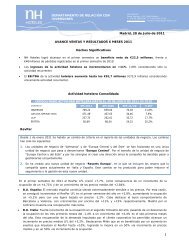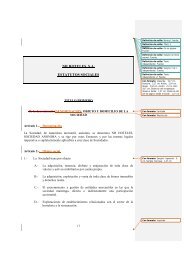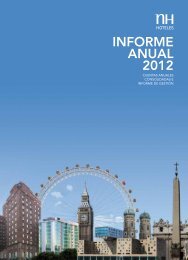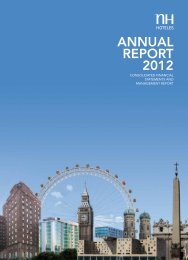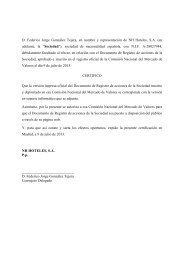Consolidated Financial Statements and Consolidated Management ...
Consolidated Financial Statements and Consolidated Management ...
Consolidated Financial Statements and Consolidated Management ...
You also want an ePaper? Increase the reach of your titles
YUMPU automatically turns print PDFs into web optimized ePapers that Google loves.
- Determination <strong>and</strong> monitoring of the scope of the Internal <strong>Financial</strong> Information Control System. Definition of its scope involves determining the<br />
relevance of each of the Group’s Business Units, <strong>and</strong> whether they should be included within the <strong>Financial</strong> Information Control System, as well as<br />
identifying which significant operational <strong>and</strong> support processes should be analysed within each Business Unit. Both quantitative <strong>and</strong> qualitative<br />
criteria have been taken into account in determining this scope.<br />
The determination <strong>and</strong> review of this scope, as previously described, are fully documented within the <strong>Financial</strong> Information Control System, <strong>and</strong> must<br />
be overseen by the Group’s <strong>Financial</strong> Department. It is approved annually by the Audit <strong>and</strong> Control Committee.<br />
This process covers all the basic objectives of financial information: existence <strong>and</strong> occurrence; completeness; valuation; disclosure, breakdown <strong>and</strong><br />
comparability; rights <strong>and</strong> obligations.<br />
Aside from the previously-described process, the <strong>Financial</strong> Department carries out a monthly accounting consolidation process.<br />
This process starts with the consolidated accounts being received from the various Business Units each month. These are checked <strong>and</strong> approved to<br />
ensure they comply with the established principles of control, co-management <strong>and</strong> significant influence.<br />
The last phase of this process includes verification of the st<strong>and</strong>ardisation adjustments affecting the income statement (monthly) <strong>and</strong> the balance sheet<br />
(quarterly).<br />
This means all the Business Units share a documentation <strong>and</strong> consolidation system that is approved by the <strong>Financial</strong> Department, which reviews it once<br />
a year.<br />
It is important to stress that the Company has a single Accounts Plan for the entire Group, as well as shared management IT tools in all the Business Units.<br />
3. Main features of the Control Activities<br />
The Internal <strong>Financial</strong> Information Control System defined within the group’s control structure involves detailed work to identify not just the group<br />
companies to which it should apply, but also the map of the most significant processes within each of them. The most relevant processes include<br />
reporting, accounting closure, consolidation, opinions <strong>and</strong> estimates.<br />
In order to ensure the reliability of the <strong>Financial</strong> Information, accounting errors that may arise from the following control objectives are always borne<br />
in mind:<br />
• Completeness: balances or transactions that should be recorded but are not.<br />
• Transaction cut-off: those booked in a period other than when they were accrued.<br />
• Accuracy: transactions recorded with errors (amounts, conditions).<br />
• Occurrence/ Existence: transactions that have taken place within the period.<br />
• Valuation/Allocation: record of transactions involving incorrect sums due to inadequate valuation calculations.<br />
• Presentation/ Classification: classification errors in the various entries of the financial statements.<br />
The controls <strong>and</strong> procedures defined within the Internal <strong>Financial</strong> Information Control System support the relevant processes to ensure the proper<br />
functioning of the information systems, such as secure access, monitoring of changes in the systems, operational continuity <strong>and</strong> separation of<br />
functions.<br />
Supervision of the management of activities outsourced to third parties, as well as any possibly relevant evaluation, calculation or valuation tasks<br />
commissioned from independent experts are also covered by this control structure.<br />
The Group’s <strong>Financial</strong> Department sends the <strong>Management</strong> Report to the Board of Directors once a month, to be reviewed. This report includes all<br />
the most relevant financial <strong>and</strong> management information, the income statement <strong>and</strong> the main economic indicators <strong>and</strong> ratios. A balance sheet is also<br />
submitted each quarter<br />
The Board of Directors periodically requests an analysis of specific issues, as well as the details of particular financial transactions that, because of their<br />
importance, need to be studied in greater depth.<br />
The Chairman of the Audit <strong>and</strong> Control Committee periodically reviews this financial information during its meetings <strong>and</strong>, as required, requests the<br />
attendance of either external <strong>and</strong>/ or internal auditors.<br />
4. Information <strong>and</strong> Communication<br />
The Company’s Organisation <strong>and</strong> Systems Department is responsible for unifying, analysing <strong>and</strong> publishing all the st<strong>and</strong>ards <strong>and</strong> procedures that<br />
apply to the Company, particularly operational, administrative (including accounting), quality <strong>and</strong> regulatory rules. It is the responsibility of each of the<br />
departments (financial, operations, purchases, commercial, etc.) to issue <strong>and</strong> oversee regulations that relate to their area <strong>and</strong> form an integral part of<br />
the Company’s internal control.<br />
Although the functions relating to accounting criteria are the responsibility of the Organisation <strong>and</strong> Systems Department, the <strong>Financial</strong> Department<br />
is responsible for defining <strong>and</strong> applying the accounting criteria, with this department being in charge of ensuring these are updated <strong>and</strong> approved.<br />
To do this, the Company currently has a common Accounts Plan, an Accounting Regulations Manual <strong>and</strong> a Consolidation Manual, which apply in all<br />
the countries in which the Group operates <strong>and</strong> are updated at least once a year. This body of regulations contains the requirements of international<br />
financial reporting st<strong>and</strong>ards (IFRS), which are the accounting regulations used within the Group.<br />
Interpretation <strong>and</strong> application of the financial reporting regulations is the responsibility of the Group’s <strong>Financial</strong> Department, which updates <strong>and</strong> checks<br />
any possible new regulatory developments relating to the generation of financial information twice a year.<br />
5. Supervision of the system<br />
The Audit <strong>and</strong> Control Committee is responsible for supervising internal control, which it does by means of the Internal Audit Department, which<br />
attends the sessions of the Audit <strong>and</strong> Control Committee whenever the committee feels this to be necessary.<br />
The Audit <strong>and</strong> Control Committee regularly carries out the following supervisory <strong>and</strong> control functions, as specified in Article 25 b) of the Regulation<br />
of the Board of Directors:<br />
58<br />
ANNUAL CORPORATE GOVERNANCE REPORT



